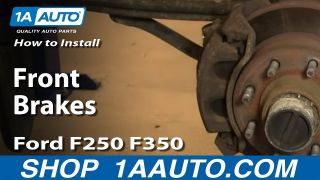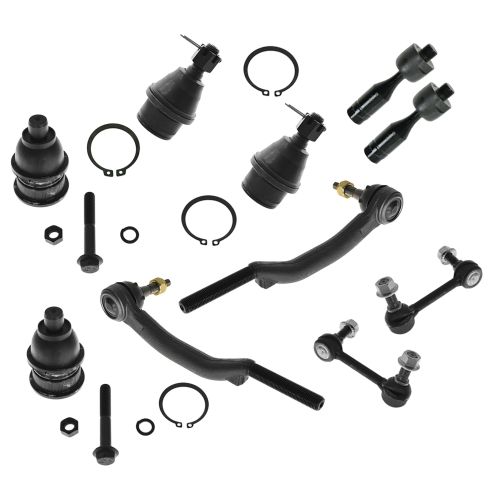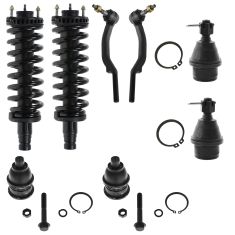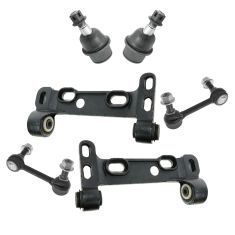Replaces
2007 Isuzu Ascender Front 10 Piece Steering & Suspension Kit TRQ PSA56310
Part Details
- Quantity: 10 Piece
-
Kit Includes:
(2) Front Lower Ball Joints
(2) Front Outer Tie Rods
(2) Front Sway Bar Links
(2) Front Upper Ball Joints
(2) Front Inner Tie Rods
Specification
- Front
TRQ suspension kits are manufactured using premium raw materials and coatings for extended service life. Each TRQ suspension component is designed to be a direct, maintenance-free replacement to the stock unit. To extend the life of your steering and suspension components, TRQ recommends replacing components in pairs, sets, or kits. All products are fit and road-tested in our Massachusetts R&D facility to ensure we deliver on our promise of Trusted Reliable Quality.
Product Features
Install Tip: When replacing steering components, have a professional alignment performed afterwards. This ensures proper tracking and even tire wear.
Our steering and suspension components are pre-greased and sealed for long life and do not require the extra maintenance typically required by greaseable versions.
Item Condition:
New
Attention California Customers:
![]() WARNING: This product can expose you to chemicals including Lead and Lead Compounds, which are known to the State of California to cause cancer, and birth defects or other reproductive harm. For more information, go to www.P65Warnings.ca.gov.
WARNING: This product can expose you to chemicals including Lead and Lead Compounds, which are known to the State of California to cause cancer, and birth defects or other reproductive harm. For more information, go to www.P65Warnings.ca.gov.
Lifetime Warranty
This item is backed by our limited lifetime warranty. In the event that this item should fail due to manufacturing defects during intended use, we will replace the part free of charge. This warranty covers the cost of the part only.
FREE Shipping is standard on orders shipped to the lower 48 States (Contiguous United States). Standard shipping charges apply to Hawaii and Alaska.
Shipping is not available to a P.O. Box, APO/FPO/DPO addresses, US Territories, or Canada for this item.
Expedited is available on checkout to the United States, excluding Alaska, Hawaii.
Final shipping costs are available at checkout.







Created on:
Tools used
- Pry the center cap off. Loosen the lug nuts. Raise the vehicle. Remove the lug nuts. Remove wheel. (If it is stuck, replace one lug nut and hit the wheel till it brakes loose).
- Remove the two bolts on the back of the brake calipers. Place a screwdriver in the side of the caliper and pry the brake pistons back in. Remove the Caliper. Pull the brake pads out and remove the spring.
- Remove the two 21mm bolts from the bracket. (Use a breaker bar or piece of pipe for leverage. Remove the caliper bracket. Spray the studs and hub with penetrating oil and let it sit. Pry the disc free from the hub.
- Put the rotor in place. Replace the slides in the brake calipers with the new slides. Replace the caliper bracket. Reinsert the 21mm bolts in the bracket. Torque to 145ft/lbs. Put your old pads in the caliper bracket and use a c-clamp to push the pad into the caliper and reset the pistons. Wire brush the slides if old, and put them back into place. Slide the new pads into place. Put the caliper back into place and reinsert the caliper bolts. Torque to 23 - 25ft/lbs.
- Put the wheel into place. Replace the lug nuts. Lower the vehicle and tighten the lug nuts in a crossing pattern. Torque to 120ft/lbs. Replace the center cap.
- Pump the brakes until they are firm. Test stopping from 5mph Test stopping from 10mph.
Brought to you by 1AAuto.com, your source for quality replacement parts and the best service on the internet.
In this video, we're going to show you how to check and replace the front brakes on this 2003 Ford F250 Super Duty. Obviously we do the passenger side. You would want to repeat the driver side afterwards. You always want to replace your brakes in pairs.
Tools you'll need are jack and jack stand, 16, 17 and 21 millimeter sockets. You'll need a breaker bar or a pipe for some leverage or for some of those lug nuts or other bolts that are difficult. If your vehicle, like ours, is from the Northeast, you might need a large hammer and a large pry bar to get the tire off as well as possibly to get the rotor off, large flat blade screwdriver, a small wire brush, large C-clamp and torque wrench.
Okay, you'll need a large screwdriver or pry bar. It doesn't have to be this big but there's a little slots back in the back. Going to pry out. The next one, that pulls right off. Okay, if you don't have to benefit of impact tools, you want to loosen the lug nuts while the truck is on the ground, then raise and support the vehicle and remove the lug nuts these are 21 millimeter. Here I'll just fast forward as I remove the lug nuts from the wheel. Okay, so my tire is basically just stuck onto the hub, so I put a lug nut back on. That just helps if your tire breaks loose, it doesn't go flying off and hurt you because it can be heavy. Give it some pulls. I try the foot method. It doesn't seem to work. Okay, neither of those methods work, then a nice big hammer. Hit the back of the tire. You don't want to hit the rim because you don't want to bend it and that'll get your wheel loose. Then you remove that lug nut and take the wheel and tire off.
Okay, so inspection of the brakes. You want to check your rotors. You can check the condition of your rotors. You can see they're in pretty good shape visually. Not a lot of rust. Take the back of your fingernail, run it up and down. You'll feel slight groves but you shouldn't feel much. Same thing back side. You shouldn't feel any deep grove. Okay. Then, looking in here, you can see there's your rotor. You see there's quite a bit of life left on the inner pad and then the outer pad has quite a bit of life left there as well.
Next thing you want to do is remove these calipers. You want to remove two bolts, one here and then one right down here. Okay, these bolts should both be 16 millimeter. On this truck, my lower bolt's 16 millimeter, my upper bolt is 14 millimeter. They should come off pretty easily with a regular ratchet. I'll fast forward through removing those. Again, on this truck, there were two different sizes. I believe one of them was replaced from a previous repair. They probably should both be 16 or 17 millimeter.
Okay. As your brakes wear, they have a self adjusting mechanism which is basically the pistons come out of the caliper. You can use a large screwdriver and this is to reset those pistons as well as to help you get the caliper off, but you can just see I'm prying out and if you watch, I'll be forcing the caliper out which is actually forcing the pistons back in. Okay. Now, the caliper's nice and loose. The caliper comes right off. Set it right here on the leaf spring. Okay. You can see there are two little return springs and you can take your outer pad out. I'll move that spring there. You see on my brakes, my outer pad, this is a wear indicator. There's still plenty of life left on there. I'll take my inner pad. Okay, the same thing that wear indicator, plenty of life in it.
Now, if you want to remove or replace your rotors, you're going to have to remove this caliper bracket. There's two 21 millimeter bolts here and down here. These bolts are going to be very tight. The right tool for the job is a good size breaker bar. if you don't have that, you can use your ratchet handle and a nice piece of pipe like this to give yourself some extra leverage to get them started.
Okay, and we'll fast forward here as I remove those bolts the rest of the way and then remove that caliper bracket. On a Northeastern truck like ours, you may run into the discs being pretty well seized onto the hubs, penetrating oil around the studs and as well as around the hub. I rotate it more and let it sit for a while. Use a large hammer. Be careful not to hit the wheel studs. Tap it in and then from the top, just to try and break it loose. Sometimes it'll break loose with just this. Then, the last thing is, you can use a pry bar. Put it between the steering knuckle and the disk and it'll come free. Here goes the new one. It slides right back into place.
Okay. As you can see, the brakes on the truck didn't really need to be replaced but we like to test fit the new parts from 1A Auto. Make sure everything fits on there great and you're going to have a good experience. Right here, I'm just fast forwarding. I just put a couple of lug nuts on, helps hold the rotor into place so you can put everything together easily. In your caliper bracket, there are little slides that the brake shoes run. You want to take those out, replace them with the new ones from your new pads. if your pads do not come with them, you want to clean them with a wire brush.
Okay. Also, you want to check both these. They should slide back and forth nice and easy like these do. If they're catching at all, take them out. Wire brush them, regrease them and put them back in, okay. Now, you take this caliper bracket. Put it in place. Okay and fast forward as I start those nuts in. What I notice is on starting them in is that the bracket is hitting on the rotor and so what I do is take my impact wrench, put another lug nut on and tighten those up and you can see the rotor goes in, then just remove the lug nuts and continue on here and just preliminarily tighten up those caliper bolts. You want to torque these to 145 foot-pounds. As your pads wear, your pistons work themselves out of the caliber. What you need to do is reset them, so I got my old pad here. Put that in place, then I use a large C-clamp. Okay. As I tighten the clamp, you'll see the two pistons move pull back in the caliper, all right.
Okay. They're all set. Okay. I use the wire brush, clean off my slides here and when you put these back in, they do have sides. Push down and make sure that is towards the bracket. See, this won't go up here. Okay. New pads from 1A Auto. Take them, push them up in, and slide them into place. Make sure they're in. Push in the sliding one there. Okay, I'll just fast forward as I start the bolts for the caliper to the bracket. Okay. These bolt I'm going to tighten, I'm going to torque between 23 and 25 foot-pounds.
Okay, speed up the tape here a little bit as I put the wheel back on, start the lug nuts by hand first and then I'll preliminary tighten them up with the ratchet. Okay, now I torqued the lug nuts to 120 foot-pounds, using a crossing pattern and then I go around one by one and make sure they're all torqued.
Okay. Put the center cap back on and then, very important, make sure you pump your brakes a bunch of times. This resets the pistons and the calipers. Then, before you drive your vehicle on the road, just do a test stop from 5 and 10 miles an hour. Make sure the brakes are working properly.
We hope this helps you out. Brought to you by www.1AAuto.com, your source for quality replacement parts and the best service on the internet. Please feel free to call us toll free, 888-844-3393. We're the company that's here for you on the internet and in person.
Tools used
Tools used
Tools used
Okay, friends, one of the first things we need to do to start this job is to safely raise and support the vehicle. I like to raise it directly on the frame. Once you have the wheel off the ground, we're going to remove our center cover. That exposes our 19-millimeter lug nuts. Remove them all and then remove the wheel. Okay. So we took the wheel off so we have a nice, clear view of the sway bar link here. You don't necessarily have to, but it makes it easier to see. What you're going to need is a 7-millimeter Allen head. I'm going to come right in here and I'm just going to give it a couple of nice bonks. Now we're going to take our 21-millimeter wrench, put it right over this nut. The next thing we're going to do is use a ratchet or an air gun, whatever you have, put it on here. And when we turn this, we actually want to try to turn it so we're tightening. It's going to sound weird, but essentially we want the ratchet so it's tightening and the wrench so it's turning to the left. We'll break that free and then we'll go like this, and what you'll notice is it starts loosening up. Remove that completely. There we go. Do the same to the top.
Okay. I'll get my tool off of here. There we are, friends. Once you've compared the new sway bar link to your old sway bar link, it's going to be time for the install. You're going to notice your new sway bar link came with some nice new washers. Those washers are going to go on before you install. Slide them right in, and they're going to go up against this nutted area. Start it in the control arm, and then I'll put it in the sway bar. I'm just going to get this bent down. Slide it right in there. Perfect. We've got our two nuts here. Start them both on. Now it's going to be time to tighten these up. To get onto that nut that's on the inside there, use your 17-millimeter wrench. Now I'm going to use a 21-millimeter and I'm going to snug this up. All right. That bottomed out. Do the same to the other one and then we'll torque them down. Now we're going to torque these to 107 foot-pounds.
It's always a great idea to double-check everything that you removed and replaced. Just make sure everything's secure and good to go. Once you've done that, let's go ahead and get the wheel up on here. Bring the vehicle down so the tire is just barely touching the ground, so it can't spin. And then torque the wheels in a criss-cross manner to 103 foot-pounds. Now it's going to be time to get our center cover on here. If you were to turn it around, you might see something that looks a lot like a valve stem. Line it up with your valve stem and then go ahead and pop it on there.
Tools used
Tools used
Tools used
- Pry off the hub cap with a flat blade screwdriver Loosen the 35mm hub nut with the vehicle on the ground Loosen the lug nuts Raise the vehicle with a floor jack Secure the vehicle on jack stands Remove the lug nuts Pull off the wheel
- Spray both ends of the outer tie rod with penetrating oil Measure from the either end of the outer tie rod Place a 26mm wrench on the larger nut Place a 22mm wrench on the smaller nut Break the 22mm nut free Straighten the cotter pin with pliers and pull it through Remove the nut with a 21mm socket from the wheel knuckle Hit the wheel knuckle with a hammer Twist off the outer tie rod Remove the 22mm nut off the outer tie rod
- Mark where the 22mm nut was located on the old tie rod to the new tie rod Screw on the nut Twist the outer tie rod into place Push the outer tie rod into the wheel knuckle Measure and check the outer tie rod distance Tighten the 21mm nut on the wheel knuckle Insert and twist the cotter pin with a pair of pliers Tighten the two nuts on the outer tie rod
- Slide the wheel into place Start the lug nuts by hand Tighten the lug nuts preliminarily Lower the vehicle to the ground Tighten the hub nut Torque the lug nuts to 100 ft/lbs in a crossing or star pattern Torque the hub nut to 103 ft/lbs Reattach the center cap
Brought to you by 1AAuto.com, your source for quality replacement parts and the best service on the Internet.
Hi, I'm Mike from 1A Auto. I hope this how-to video helps you out, and next time you need parts for your vehicle, think of 1AAuto.com. Thanks.
In this video, we're going to show you how to replace an outer tie rod on this 2003 GMC Envoy XL. We show you on the passenger side, but the driver side is a similar procedure. The items you'll need for this include a new outer tie rod from 1AAuto.com, 19mm and 21mm socket and ratchet, 10mm, 22mm and 26mm wrenches, flat blade screwdriver, tape measure, pliers, hammer, torque wrench, and jack and jack stands.
Start by removing your wheel and tire. Pry off the cap first. If you don't have the benefit of air tools, you'll want to loosen the lug nuts, then raise and secure the vehicle on jack stands, and remove the lug nuts the rest of the way. We have air tools, so we put the vehicle up on jack and jack stands, remove the lug nuts, and remove the wheel and tire.
Start off by just spraying both ends of your outer rod with some penetrating oil. This will just help to remove those nuts. Then you want to measure from the end of the first nut on the outer tie rod to the center of this nut. You can see we actually marked on the outer tie rod where you should measure to. You want to make sure when you put your new outer tie rod on that it's the same distance.
Put a 26mm wrench on the larger nut and a 22mm wrench on the smaller nut. Just break that smaller one free. Now, using a pair of pliers, just straighten out this cotter pin. Once it's straightened out, try to hit it through or pull it through. If it doesn't move, then you can just break off this end. You just move each tab up and down until it breaks off. After you've done that, you can again try pulling it from the other side. If that doesn't work, you can just use a hammer and a punch.
Using a 21mm socket, just remove that nut. Hit the wheel knuckle with a hammer. That will just break that free. Then you can just twist your outer tie rod off. Now, just remove that nut on the outer tie rod the rest of the way.
I can see that my bolt was on to here, so I'm just going to make a mark on the new one to here. That's where I'm going to put my bolt onto, just a preliminary alignment. Twist the outer tie rod into place. Make sure that rubber boot is back on there. Then push the outer tie rod up into the wheel knuckle.
Just measure and make sure it's the same distance. If it is, you're all set. If not, you want to just adjust the nuts on the end of the outer tie rod. Since it is, we're just going to replace this nut and tighten it up. You can see we're using a 10mm wrench to just hold the stud steady. Now just tighten up these two nuts.
Replace your wheel. Replace the lug nuts and tighten them up preliminarily. Lower the vehicle. Tighten them the rest of the way, and torque each of them to 100 foot-pounds in a crossing pattern.
We hope this video helps you out. Brought to you by www.1AAuto.com, your source for quality replacement parts and the best service on the Internet. Please feel free to call us toll-free, 888-844-3393. We're the company that's here for you on the Internet and in person.
Product Reviews
877-844-3393
Monday - Friday 8:00am - 9:30pm ET
Saturday - Sunday 8:00am - 4:30pm ET
Specify your vehicle's year, make and model to guarantee fit.
This part doesn’t fit a . Select from parts that fit.





















